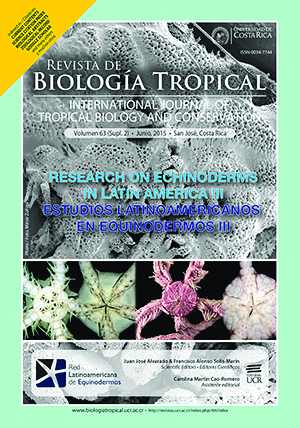Abstract
Several species of sea urchins are a potential resource for the production of gonads for consumption in Venezuela. We studied the gametogenic cycle and the gonadosomatic index (GSI) of the rock boring urchin Echinometra lucunter between June 2010 and November 2011 in northeastern Venezuela (Isla Lobos, Península de Araya and Turpialito, Gulf of Cariaco). The gonads are composed of long ramified acini, covered by connective tissue, followed by a thin layer of cells that differentiate into nutritive phagocytes and gametes, which change in their proportion and size with the maturity stage. Generally, several maturity stages were observed in both locations, showing simultaneous spawning. At Isla de Lobos the individuals in reserve stage predominated with a short period of sexual maturity, while mature and spawned individuals predominated in Turpialito. The GSI suggests that the greatest spawning activity is associated to the rainy season; showing a conservative reproductive activity, accruing energetic reserves during the period of higher primary productivity associated to coastal upwelling, when the energy of nutritive phagocytes is transferred to gametes, for gamete development and spawning. The biological and reproductive characteristics of individuals at Turpialito showed higher GSI having more gonadal tissue for commercial consumption.
References
Alsaffar, A., & Khalid, P. (2000). Reproductive cycles of Diadema setosum and Echinometra mathaei (Echinoidea: Echinodermata) from Kuwait (Northern Arabian Gulf). Bulletin of Marine Science, 67, 845-856.
Astudillo, D., J. Rosas, A. Velásquez, T. Cabrera & C. Maneiro. 2005. Crecimiento y supervivencia de larvas de Echinometra lucunter (Echinoidea: Echinometridae) alimentadas con las microalgas Chaetoceros gracilis e Isochrysis galbana. Rev. Biol. Trop. 53 (Supl. 3): 377-344.
Cameron, R. 1986. Reproduction larval occurrence and recruitment in Caribbean sea urchins. Bull. Mar. Sci. 39: 332-346.
Cruz-Motta, J. (2007). Análisis espacial de las comunidades tropicales intermareales asociadas a los litorales rocosos de Venezuela. Ciencias Marinas, 33, 133-148.
Espinoza, R., Reyes, J., Himmelman, J., & Lodeiros, C. (2008). Actividad reproductiva de los erizos Lytechinus variegatus y Echinometra lucunter (Echinodermata: Echinoidea) en relación con factores ambientales en el Golfo de Cariaco, Venezuela. Revista de Biología Tropical, 56(Suppl. 3), 341-350.
Hendler, G., Miller, J., Pawson, D., & Porter, K. (1995). Sea Stars, Sea Urchins, and Allies. Echinoderms of Florida and the Caribbean. Washington: Smithsonian Institution Press.
Johnson, R., & Wichern, D. (1992). Applied multivariate statistical analysis. New York: Prentice-Hall:
Lawrence, J. (2007). Edible sea urchins: use and life-history strategies. In J. M. Lawrence (Ed.), Edible Sea Urchins: Biology and Ecology (pp. 1-9). Amsterdam: Elsevier.
Lessios, H. A. (1981). Reproductive periodicity of the echinoids Diadema and Echinometra on the two coasts of Panama. Journal of Experimental Marine Biology and Ecology, 50, 47-61.
Lessios, H. A. (1991). Presence and absence of monthly reproductive rhythms among eight Caribbean echinoids off the Coast of Panama. Journal of Experimental Marine Biology and Ecology, 153, 27-47.
Lewis J., & Storey, G. (1984). Differences in morphology and life history traits of the echinoid Echinometra lucunter from different habitats. Marine Ecology Progress Series, 15, 207-211.
Lima E., Gomes, P., & Souza, J. (2009). Reproductive biology of Echinometra lucunter (Echinodermata: Echinoidea) in a northeast Brazilian sandstone reef. Anais da Academia Brasileira de Ciências, 81, 51-59.
Lovatelli, A., & Sarkis, S. (Eds.). (2011). A regional shellfish hatchery for the Wider Caribbean: Assessing its feasibility and sustainability. Roma: FAO.
Lodeiros, C., Martín, A., Francisco, V., Noriega, N., Díaz, Y., Reyes, J., & Alió, J. (2013). Echinoderm from Venezuela: Scientific recount, diversity and distribution. In J. J. Alvarado, & F. A. Solis-Marin (Eds.), Echinoderm Research and Diversity in Latin America (pp. 235-275). Berlin: Springer.
Mahdavi, N., Haghighat, Z., Karamzadeh, S., Naseri, F., Esteki. A, & Rameshi, H. (2008). Reproductive cicle of the sea urchin Echinometra mathaei (Echinodermatidea) in the Persina Gulf, Iran. Journal of Biological Science, 8, 1138-1148.
Mariante F., Lemos, G., Eutrópio, F., & Gomes, L. (2009). Biología reprodutiva de Echinometra lucunter (Echinodermata: Echinoidea) na Praia da Costa, Vila Velha, Espírito Santo. Zoología, 26, 641-646.
Martínez, A. (1986). Equinodermos de la Isla de Aves, Venezuela. Boletin del Instituto Oceanográfico de la Universidad de Oriente, 25, 195-213.
Martínez-Pita, I., García, F., & Pita, M. (2010). The effect of seasonality on gonad fatty acids of sea urchins Paracentrotus lividus and Arbacia lixula (Echinodermata: Echinoidea). Journal of Shellfish Research, 29, 517-525.
McPherson, B. (1969). Studies of the biology of the tropical sea urchins Echinometra lucunter and Echinometra viridis (Echinoidea) in Bostaneh, Persian Gulf, Iran. Bulletin of Marine Science, 19, 194-213.
Montealegre, S. & Gómez, A. (2005). Ciclo reproductivo de Lytechinus variegatus (Echinoidea: Toxopneustidae) en el sur de Isla Margarita, Venezuela. Revista de Biología Tropical, 53(Supl. 3), 305-312.
Pearse, J., & Cameron, R. (1991). Echinodermata: Echinoidea. In A. C. Giese, J. S. Pearse, & V. B. Pearse, (Eds.), Reproduction of Marine Invertebrates, Vol. VI, Echinoderms and Lophophorates (pp. 513-622). Pacific Grove: Boxwood Press.
Walker, C., Tatsuya, U., & Lesser, M. (2007). Gametogenesis and reproduction of sea urchins. In J. M. Lawrence (Ed.), Edible Sea Urchins: Biology and Ecology (pp. 11-33). Amsterdam: Elsevier.
Zar, J. (2010). Biostatistical Analysis. USA: Pearson Education.
Zoppi, E. (1967). Contribución al estudio de los equinodermos de Venezuela. Acta Biologica de Venezuela, 5, 267-283.
##plugins.facebook.comentarios##

This work is licensed under a Creative Commons Attribution 4.0 International License.
Copyright (c) 2015 Revista de Biología Tropical






